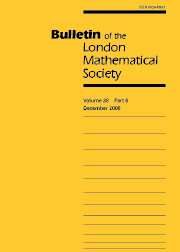Article contents
QUANTUM MARKOV PROCESSES WITH A CHRISTENSEN–EVANS GENERATOR IN A VON NEUMANN ALGEBRA
Published online by Cambridge University Press: 01 September 1999
Abstract
Let [Ascr ] be a unital von Neumann algebra of operators on a complex separable Hilbert space ([Hscr ]0, and let {Tt, t [ges ] 0} be a uniformly continuous quantum dynamical semigroup of completely positive unital maps on [Ascr ]. The infinitesimal generator [Lscr ] of {Tt} is a bounded linear operator on the Banach space [Ascr ]. For any Hilbert space [Kscr ], denote by [Bscr ]([Kscr ]) the von Neumann algebra of all bounded operators on [Kscr ]. Christensen and Evans [3] have shown that [Lscr ] has the form
formula here
where π is a representation of [Ascr ] in [Bscr ]([Kscr ]) for some Hilbert space [Kscr ], R: [Hscr ]0 → [Kscr ] is a bounded operator satisfying the ‘minimality’ condition that the set {(RX−π(X)R)u, u∈[Hscr ]0, X∈[Ascr ]} is total in [Kscr ], and K0 is a fixed element of [Ascr ]. The unitality of {Tt} implies that [Lscr ](1) = 0, and consequently K0 = iH−½R*R, where H is a hermitian element of [Ascr ]. Thus (1.1) can be expressed as
formula here
We say that the quadruple ([Kscr ], π, R, H) constitutes the set of Christensen–Evans (CE) parameters which determine the CE generator [Lscr ] of the semigroup {Tt}. It is quite possible that another set ([Kscr ]′, π′, R′, H′) of CE parameters may determine the same generator [Lscr ]. In such a case, we say that these two sets of CE parameters are equivalent. In Section 2 we study this equivalence relation in some detail.
- Type
- NOTES AND PAPERS
- Information
- Copyright
- © The London Mathematical Society 1999
- 2
- Cited by


